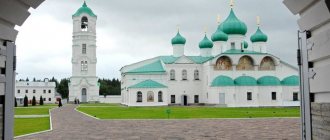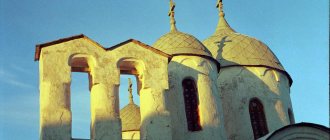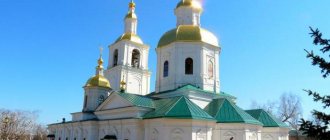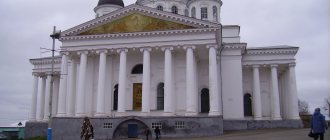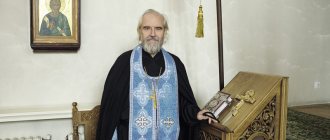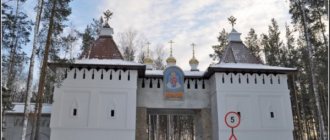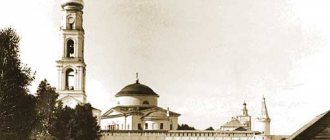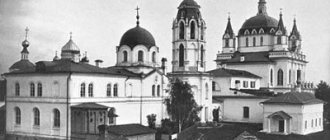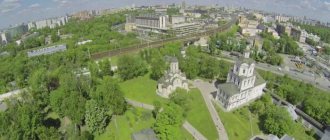Dochiar Monastery (Greece) - description, history, location. Exact address and website. Tourist reviews, photos and videos.
- Last minute tours
to Greece
Located on the coastline, the majestic monastery of Dochiar is the first of the monasteries of the Holy Mountain to appear to the gaze of pilgrims and travelers arriving on the peninsula from the “mainland” Ouranoupolis. Dokhiar ranks 10th in the hierarchy of Athos monasteries, but in terms of area and number of buildings it is one of the largest. The monastery was founded in the 10th century by Saint Euthymius of Athos, and its main temple was consecrated in honor of the Archangel Michael. One of the most revered icons of the Mother of God is also kept here - the miraculous “Quick to Hear”, painted in the first years of the monastery’s life. Other relics include a particle of the Life-Giving Cross, a shroud with the blood of St. Demetrius of Thessaloniki and particles of the relics of numerous saints.
Dochiara is easily accessible on foot from nearby Xenophon: the path lies among orchards and olive groves and takes about a quarter of an hour.
The Dohiar monastery was located on the site of the current village of Daphni
The monastery was located on the site of the current village of Daphne. But this monastery was ravaged by pirates, and therefore the brethren had to flee into the forest, taking with them some shrines from the monastery. After the destruction of the monastery, the monks returned from the forest to the monastery, but found only ruins there.
The monastery was visible from afar, it was constantly seen by pirates, because of this it was constantly attacked. Therefore, the monastery had to be moved to a new location so that it would not be visible to enemies. For the construction of the monastery, a rather inaccessible plot of land was chosen, where they decided to build a small monastery in honor of St. Nicholas.
After the situation in Byzantium returned to normal, at least a little, stabilized, and the country began to have at least some support, the monks decided to return the monastery to its original location. But it is worth saying that at that time there was no road to Athos; all ways to approach this place were only by sea.
At the site of the construction of a new monastery, there was a small temple in honor of the Archangel Michael of God. The new abbot, who was appointed to the position of caretaker of the new monastery, had a rather important position at court, which is why he donated his funds to the construction of the monastery of Holy Mount Athos.
In addition to the monastery, he also built a bakery and refectory for the monks, everything that was necessary for the normal life of the monastery. Also, the new abbot acquired a small land on which he planted grapes, and also bought cattle, which were subsequently looked after by the brethren themselves. After this, he decided to build a new temple worthy of a monastery and began construction on the site of the old church in the name of the Archangel Michael of God.
The legend says that there was still not enough money to build the monastery, but the Queen of Heaven revealed to one novice the place where the treasure was buried.
The holy archangels Gabriel and Michael saved the Dohiar monastery from troubles more than once
One day a boy and three monks were sent for this treasure. The monks wanted to kill the boy and take the treasures for themselves, but the holy archangels Michael and Gabriel saved the boy and transferred him to the altar of the temple. This is how the angels helped the child avoid death.
The crime committed by the monks was discovered and the treasures that were found were taken to build the monastery. After some time, this boy, who was saved by the archangels, became the abbot of this monastery - his name was Barnabas.
This man worked a lot for the benefit of the monastery. They say that the stone that was tied around the neck is still kept in the monastery. Soon the monastery was destroyed.
DOHIAR
The monastic legend about the founding of the monastery is recorded in the later “Tale of the miracles of the great officials Michael and Gabriel in the holy great monastery of Dokhiar on the Holy Mountain.” According to the “Tale...”, the founder of D. was Mon. Euthymius, contemporary and friend of St. Athanasius of Athos († c. 1000), he met the Crimea during his stay in K-pol. Euthymius performed in the founded st. Athanasius to the Great Lavra, obedience to the dochiar (cellarer). With the blessing of Athanasius, Euthymius, together with other monks, founded next to the modern one. Daphne's pier is a small monastery, named Dohiar after the former position of its founder. This monastery was soon destroyed by Saracen pirates, and Euthymius erected a new monastery in the name of St. Nicholas the Wonderworker, on the site of the modern one. D. with the approval and blessing of Father and Priest. Kinota.
Reverends Euthymius and Neophytos, founders of the Dochiar monastery. Icon. Con. XX century Reverends Euthymius and Neophytos, founders of the Dochiar monastery. Icon. Con. XX century
If we identify the founder with “Euphemius the monk and abbot”, who signed the Typicon of the Emperor in 972. John I Tzimisces (Meyer. R. 150), it turns out that the monastery arose between 963 (the time of the founding of the Great Lavra, where he was a dochiar) and 972. (Παπαδόπουλος. Σ. 214). Dr. researchers, citing the lack of written references to D. in the 10th century, attribute its foundation to the end. X - start XI century (Παρουσία. Σ. 39). According to N. Ikonomidis, the 1st abbot of D. was John, dochiar of the Xiropotamus monastery (Actes de Docheiariou. P. 5, 23), whose signature appears on the acts of the Great Lavra of 1016 and 1018. (Actes de Lavra. Pt. 1. P., 1970. N 19. (ArAth; 5)). According to Mon. Dorotheus, John was abbot after Euthymius (Ϫωρόθεος, μον. Σ. 179-180).
One way or another, the first written mention of the original monastery of D. dates back to 1013, when mon. Theodul signed 2 documents of the Assembly in Kareya; in 1015 he signed himself as “monk of Dochiar”, in 1020 - as “monk and abbot of Daphne”. His signature as Abbot D. is under the Typikon of the Emperor. Constantine IX Monomakh (1045/46), and, probably, he was the successor of the abbot. St. Euphemia.
In document No. 1 of the D. archive dated 1037/38 (Actes de Docheiariou. No. 1). The name Daphne (Greek - laurel), apparently, was given to the monastery due to the abundance of these trees in that place and passed on to the present. Athonite pier. The antiquity of the foundation of the monastery, as well as its early ownership of property outside the Holy Mountain, is indicated by a message in a document dated 1037 that D. “from time immemorial” owned a large plot in Perigardikia.
The information in the “Tale...” contains certain chronological contradictions: Euthymius is presented as a contemporary of St. Athanasius of Athos and Emperor. Nikephoros III (1078-1081), as well as the uncle and predecessor of the abbot. Neophyte, who ruled the monastery at the end. XI - beginning XII century The acts indicate that the movement of the monastery to modern times. the location occurred under the successors of St. Euphemia: permission from the Archpriest of the Holy Mountain to build a new fortified monastery west of the Xenophon monastery was received between 1037 and 1089. (Actes de Xénophon / Ed. D. Papachryssanthou. P., 1986. (ArAth; 15). N 1). Archpriest Pavel, defending the interests of D., says that earlier, at the request of Archpriest Joseph, the Xenophonian abbot. Dionysius voluntarily transferred territorial possessions to the monastery of “St. Nicholas, or Dochiar.” Probably this land was purchased by D. in the 1st half. XI century, as evidenced by another document from 1344, where the monks of D. report that for 300 years this land, acquired by the ktitor, has belonged to them (Actes de Docheiariou. N 23). D.'s possessions were small and limited to the borders of Xenophon and 2 others, subsequent. of the disappeared Mont Rey. Daphne's monastery served as D.'s farmstead until 1880, when for unknown reasons this property was lost. Its ruins are south of the present day. buildings of Daphne, to the right of the road to the Simonopetra monastery, have survived to this day. time.
The new ktitor of the monastery is St. Neophyte, son of the great Duke John. According to the “Tale...”, he held the position of 1st Secretary of the Emperor. Nikephoros III Botaniates, and then the great patrician. After the death of his parents, with the permission of the emperor, at the age of 29, he retired to Athos to his uncle, Abbot D., whom he later replaced as abbot, using all his father's and personal fortune to improve the monastery. With this money, as well as with funds he received from the emperor, he built a large tower, katholikon (cathedral temple of the monastery) in the name of the arch. Michael, parekklision (chapel or separate small church) in the name of St. Nicholas the Wonderworker, cells, etc., and also acquired a courtyard for the monastery outside the Holy Mountain. Neophyte reports that he, “dismantling the former church, from the foundations erected a beautiful temple in honor of the Archangel of the Heavenly Powers Michael” and decorated it in every possible way (Actes de Docheiariou. N 6).
St. Treasures are brought to the neophyte. Painting of the catholicon of the Dokhiar monastery. 1568
St. Treasures are brought to the neophyte. Painting of the catholicon of the Dokhiar monastery. 1568
The “Tale...” says that when there was not enough money to paint and decorate the temple, a miraculous event occurred. In the courtyard of the Longos monastery (Sithonia Peninsula) there stood an ancient pillar with a bust of a certain man on top and the inscription: “Whoever hits me on the head will find a lot of gold.” Local residents, taking these words literally, unsuccessfully threw stones at the statue. A novice of the monk D. named Vasily began to dig where the shadow of the statue’s head falls at sunrise, and found a treasure of gold coins. When he reported this to Abbot. Neophyte, he gave him 3 monks to transport gold to the monastery. The monks loaded the treasures into the boat, but on the way they succumbed to temptation, tied a stone around the young man’s neck and threw it into the sea, and divided the gold among themselves and hid it not far from the monastery. Vasily, calling St. archangels, was miraculously transported by them to the monastery church, where the ecclesiarch found him sleeping with a stone around his neck. The monks told the abbot that the novice disappeared with the treasure, but St. The neophyte denounced them in the presence of a novice and expelled them from the monastery. Vasily took monastic vows with the name Varnava and later. became the successor of St. Neophyte on the abbess. Researchers do not deny the historical authenticity of this story due to not only the many expensive works and acquisitions carried out in those years, but also the purchase of very impressive possessions in the west. parts of the Chalkidiki Peninsula in 1112 and 1117, and the 1st transaction was paid for with ancient gold coins at least 2 centuries old (Actes de Docheiariou. N 3).
According to the “Tale...”, this miracle, which revealed new heavenly patrons of D., resulted in the dedication of the Catholicon, previously consecrated in the name of St. Nicholas the Wonderworker, St. archangels In the “Order” of Rev. Neophyte (after 1118) the monastery was named Mont-Rem St. arch. Mikhail. Mention of the archangels Michael and Gabriel has been found in documents since 1273 (Παρουσία. Σ. 46).
G. Smirnakis suggested that after the destruction of the 1st monastery, the monks, in search of a new refuge, built a church. St. Nicholas the Wonderworker is taller than modern times. D., and several. later they moved to the coast to the small monastery of St. Archangel, whose abbot put his signature in the 24th place under the Typikon of the Emperor. Constantine IX Monomakh (1045/46) (Σμυρνάκης. Σ. 566). However, it is most likely that it was not a monastery, but a c. arch. Michael (Παρουσία. Σ. 41).
With money from the abbot's treasure. The neophyte painted the catholicon, provided it with magnificent vessels, icons, valuable woven coverings, handwritten books, and acquired a lot of movable and immovable property for the monastery. Fame of abbots. Neophyte and his virtues prompted the fathers to make him prote of the Holy Mountain, and in this position, while remaining abbot of D., he served the Athonite monasteries for a long time. The memory of the venerable ktitors Euthymius and Neophytos, the exact date of whose death is unknown, is celebrated in D. on November 9, the day after the Council of St. archangels
D. has one of the first versions of the Athonite monastic charter in its simplest form. St. The neophyte drew up a charter and called it “Order” (Ϫιάταξις). The exact time of compilation is unknown, apparently much later than 1118 - the completion of the construction of the cathedral, which is presented in the charter as an event long past. Knowing that death was approaching, St. Neophyte wanted to appoint a successor for himself (his name is not indicated in the document, a free place was left for him, but among those who signed was Monk Barnabas, the future successor of St. Neophytos) and leave orders and commandments for future abbots (12 points) and monks (5 points). He bequeathed to the abbot to glorify the Lord and arch. Michael, keep the commandments, be virtuous, keep the covenants of the fathers and the statutes of the Holy Mountain, instruct the monks by the example of your life, and also wisely manage the property of the monastery, for example. not to sell it unless absolutely necessary and without the consent of the archpriest and the brethren, etc. The brethren are obliged to obey the abbot, like Christ Himself, to be affirmed in the virtues of abstinence, faith and love for each other, to imitate the fathers who came before and to be the first in good deeds, and also remember St. Neophyte for what he did for the monastery. Here are given only the general principles and wishes of the ktitor regarding the duties of the abbot and the brethren; for details he refers them to the Priest. Scripture, the canons of the Church and the statutes of the Holy Mountain.
Well with St. water in Dochiar monastery
Well with St. water in Dochiar monastery
Initially, D. owned a small plot of land; from 1037 he owned vast lands on the coast of the hall. Singitikos (a farmstead in Perigardikia), in 1089 acquired possession in Satuvla near the city of Ierissus. When St. Neophyte D. owned 3 farmsteads with many. lands on the Sithonia Peninsula (where the treasure was found), the Thessalonian suburb of Isonos, as well as a whole quarter in the city with 7 workshops, a courtyard, etc. buildings. In 1117, St. Neophyte sold the workshops and, with an additional payment, bought another suburb (Roseon) with many. lands and assigned peasants.
Significant contributions to D. were made by imp. Andronicus II Palaiologos (1282-1328), about whom in the “Tale...” it is said that he transferred large possessions to D. in Perigardikia and made other “many donations” (Κύριλλος Ϫοχειαρίτης. Σ. 18). Although D. owned the indicated monastery until 1037, his benefits could consist of returning what was lost and protecting the rights of the monastery. Imp. Andronikos III (1328-1341) in a special chrisovul confirmed the ktitor activity in relation to D. of his grandfather, called in some documents “the great ktitor” (Actes de Docheiariou. N 16).
In con. XIII century, under the emperor. Andronike II, D.'s long-term problem with drinking water was resolved. Until this time, water was delivered from distant sources (about 5 km) through an open land channel, as a result of which it became polluted and caused various diseases in the monks, chap. arr. swelling of the legs. Therefore, it was decided to lay ceramic pipes deep in the ground, but through the miraculous intervention of St. the archangels did not require so much expenditure from the monastery. According to the “Tale...”, appointed responsible for the construction of the monastery. Theodulus, at the direction of St. The archangels revealed the existence of a source of water to the left of the catholicon. The monks began to dig in the indicated place and, having discovered an abundant source of good drinking water, built a well. This well became a shrine to D., many came from its water. healing (Κύριλλος Ϫοχειαρίτης. Σ. 16-18).
D. also owned various lands in Kalamaria (Kalokampos and later huge areas of the Marian farmstead), on the Kassandra Peninsula, 2 large villages with lands on the island of Lemnos, fertile land in Amygdala, etc.
Gradually, partly thanks to his influence in Protata, D. acquired the possessions of the neighboring small deserted mon-rays of Nevrokop, Calligraph and Scamandrin. This was not easy, because other Athos monasteries also laid claim to the liberated lands. So, regarding the possessions of the Calligraph, there was a lawsuit with Mon-Rem Kastamonit, who had earlier begun to make efforts to acquire them, so that even an official was required. confirmation of the rights of D. by the K-Polish Patriarch Callistus I. The land, which came under the jurisdiction of Protat, was sold by him to D. in 1345 (Actes de Docheiariou. N 24), when a considerable amount of money was required to ransom the first persons of Protat, taken captive pirates. Bud. the patriarch was then among the captives, and in a document of 1355, which approved the legality of the sale, he reported that the pirates first turned for ransom to D., where the monks, on their own initiative, paid them more than 300 of the required 500 gold coins. And after this St. Kinot, as compensation for losses, D. sold him the empty monastery (Actes de Docheiariou. N 30). Serb. Tsar Stefan Dushan gave D. 2 villages in Macedonia with lands and peasants, then took them, and in 1349, as compensation, transferred the fortress in Ravenikea with all the land and inhabitants. In the fall of 1350, during the civil war in Byzantium, imp. John VI Kantakouzin took away half of D.'s possessions in Diavolokampos, Kalamaria and Ermilia and transferred them to one of the proniars, as is known from the charter of the emperor. John V Palaiologos 1355, returning them to mon-ru.
Soon, not far from Athos, an outstanding ascetic appeared - Abba John
In 1250, in this quiet and deserted place, one outstanding ascetic appeared - Abba John. Soon monks began to gather around him and began to settle in small huts. It was under the leadership of this man that the monks began to perform the feat of spiritual work. Many famous monasteries, such as Vatopedi, invited this person to the position of confessor or mentor.
It was under the leadership of Abba John that the monks of the Dokhiar monastery began to perform the feat of spiritual work
In 1299, the Dochiar Monastery experienced rather difficult times; it was located on rather infertile land, and therefore it always lacked moisture. A small source of water was found not far from the monastery.
The water was collected in special tanks and then transferred to the monastery. The water in the source was very cool, but at the same time very tasty, but on the way to the monastery, it had already warmed up and even spoiled, because of this the monks often got sick.
This matter was quite difficult and serious, the holy Archangels came to his aid, and only in this way did they solve the problem of drinking water forever. We again see how the Archangels of God help this monastery. While sleeping, one of the monks saw the holy archangels entering his cell. One of the angels said to the monk:
“...why are you destroying the monks, a lot of work and expenses, because there is water in the monastery itself...”
They took the monk by the hand and led him to the northern wall of the cathedral. They hit the ground with a pickaxe and suddenly crystal clear water began to flow from there. The angels gave it to the monk to try. Then in the morning, when the monk told the abbot about this, they began to dig in exactly the same place where the angels pointed. After a very long work, a source was opened, water flows in it to this day.
Dochiar Monastery on Holy Mount Athos
Dokhiar (Δοχειαρίου) is the keeper of the icon of the Most Holy Theotokos “Gorgoipisus”, one of the most beloved and revered on Mount Athos. The Dochiar Monastery is located on the steep southwestern slope of the Holy Mountain by the sea, between the Zograf and Kostamonit monasteries. It was founded in the 10th century. Saint Euthymius, disciple of St. Athanasius of Athos, dochiar of the Great Lavra of St. Athanasius (dochiar is the head of the food department of the monastery). In honor of his novitiate, St. Euthymius named the monastery “Dohiar”.
Tradition says that there were no funds to complete the monastery, but by the grace of the Queen of Heaven it was revealed to one boy, a novice of the monastery, how to find these funds: the place on the metokha (i.e., the site of the monastery) was indicated where the hidden treasure was located. Metoch was located on the island of Longos opposite Athos.
Two monks sent with the boy, tempted, decided to drown the boy with a stone around his neck and take possession of the treasure. But St. Archangel Michael and Archangel Gabriel saved the boy and took him to the church of the Dokhiar monastery.
The conspiracy was discovered, and the treasures went to their intended destination.
As a result of this miracle, the Dohiar monastery was dedicated to the Ethereal Powers. The monastery flourished. During the Saracen invasion, the monastery was devastated and fell into disrepair. In 1578, the Wallachian sovereign Alexander restored the monastery.
The Dohiar Monastery is surrounded by a high wall with a tower, the walls end with cell buildings.
The 16th-century cathedral church is dedicated to the Holy Archangels (celebrated on November 8 according to the Julian calendar).
In addition to the cathedral, Dohiar has 15 small churches and chapels and the cell of All Saints in Kareya. The most famous of these temples is the chapel "Gorgepicus" ("Quick to Hear"), standing near the gate to the cathedral. It contains the miraculous icon of the same name of the Mother of God Gorgepicus (Quick to Hear), one of the most beloved and revered Svyatogorsk icons.
Parts of the relics of saints are kept in Dokhiara: sschmch. Haralampia, mchch. Minas, Kirik, Mercury, St. John Chrysostom, St. Myrrh-streaming Nile, St. Peter of Athos, St. Achilleia, martyr. Panteleimon, St. David of Thessalonica, St. Philothea, St. John the Baptist, Equal to the Apostles. Mary Magdalene, martyr. Mines Kallikelada, MC. Marina, archdeacon. Evpla, military Jacob the Persian, St. Pavel Fiveyskago, ap. Andrew the First-Called, martyr. Theodore Stratilates, sschmch. Dionysius the Areopagite, St. Theodore the Inscribed, sschmch. Basil of Amasiysk, silverless. Cosmas, St. John the Merciful, martyr. Theodora Tiron and others. Part of the stone with which the novice was thrown into the sea is shown, miraculously saved by the Archangels and subsequently becoming an abbot with the name Barnabas.
In addition to the cathedral church of St. Archangels, there are 10 paraclises: the Most Holy Theotokos “Quick to Hear”, the Assumption of the Most Holy Theotokos, the Annunciation, the Three Saints, St. Forty Martyrs of Sebaste, without silver. Cosmas and Damian, martyr. St. George the Victorious and others.
The library of the Dochiar Monastery houses ancient manuscripts and books.
Not far from the monastery there is also a spring of the Archangels, under the name “Agiasma”.
Today the brotherhood numbers about 40 people.
Shrines of the Dochiar Monastery The miraculous icon of the Mother of God “Gorgoepikoos” (“Quick to Hear”, 10th century) Particles of Holy relics: the Prophet and Baptist John; equal to Maria Mandalina; sschmchch. Charalampia and Dionysius the Areopagite; mchch. Mines, Kirik and Mercury; St. John Chrysostom; prpp. Myrrh-streaming Nile, Peter of Athos, Achilios, John the Merciful, James the Persian
The story of the “Quick to Hear” icon is as follows: once in 1654, the housekeeper Father Neil walked through the dark hall where the icon of the Mother of God hung. Father Neil lit his way with a brightly burning, smoking candle. Passing by the icon, he suddenly heard someone’s voice: “Never walk here again, blaming My image with your smoky torch.” The monk thought that one of the brethren decided to play a joke on him, and a few days later he walked there again with another such candle. And again he heard a voice, this time more stern, saying: “Oh, monk, unworthy of this name, how long will you be so impudent and disrespectful of my image?” And at that very moment he became blind. Falling to his knees in front of the icon, he began to pray for forgiveness and the Mother of God answered him: “Your prayer has been heard and you will again, as you wish, regain your sight. Tell the rest of the monks: let them henceforth fall to Me in grief and sorrow, and I will readily listen to them, as well as to all rightly believing Christians who come running to Me, for they call Me Quick to Hear.” Through prayers at the icon of the Mother of God “Quick to Hear,” the Lord grants those who ask a lot of mercy and grace.
The monks of the Dohiar monastery often prayed to the holy Archangels for help
The monks from the monastery sent the harvest that was collected on these lands. When part of the harvest was loaded onto the ship that was leaving the monastery, a strong wind suddenly blew, and it was impossible to resist, so the ship was left afloat.
The monks began to pray to the archangels Michael and Gabriel to show them the way. At dawn, they found themselves in the very place where they needed to be. They happily exchanged all their goods for local ones, since there was a terrible famine in that area at that time.
The fact that a huge part of the gold that was found was spent on the monastery, pirates tried to get into the monastery in order to take possession of them. One night, a monk sentry saw pirates landing on the shore.
He gave the alarm, and all the monks took with them all the most valuable things. They climbed the tower and closed the door behind them. The youngest monks tried to somehow repel the attack. The senior monks began to pray to the archangels.
The pirates landed on the shore and gathered at the gates of the monastery, they began to demand gold from the monastery. Then suddenly the gates of the monastery were opened, and they saw a rider on a white horse, who was holding a sparkling sword in his hands, and behind this garden there was a huge number of warriors.
The pirates were greatly frightened, they fled screaming in despair, throwing away their weapons. The Monastery of the Holy Archangels - that’s what the monks called it.
The pirates saw a rider on a white horse, who was holding a sparkling sword in his hands, and behind this garden there was a huge number of warriors guarding the Dohiar monastery
Monasteries of Athos
St. Panteleimon Monastery occupies nineteenth place in the Holy Mountain hierarchy. Its other name is Rusik, based on the composition of the inhabitants. This is one of three traditionally Slavic monasteries. Most of its inhabitants are immigrants from Russia.
The monastery of the Holy Great Martyr Panteleimon is located on the southwestern coast of the Athos peninsula, between the monasteries of Xenophon and Xiropotamus.
Initially, the monastery of St. Panteleimon was located in a different place, further from the coast - now the so-called “old”, mountainous, Rusik, or Thessalonian monastery, founded at the beginning of the 11th century, is located there. It was built by a certain rich Christian from Thessaly.
According to legend, initially Russian monks on Mount Athos settled in the Xylurgu monastery. Quite quickly it was filled with immigrants from Rus', so it soon became crowded here. Therefore, the Holy Kinot, at the request of Abbot Lawrence, handed over to the monks the Thessalonian monastery, which was empty by that time; the monastery of Xylurgu was transformed into a monastery and remains so to the present day.
There are almost no sources about the history of Rusik until the 13th century due to a fire that completely destroyed the entire monastery along with the archives and library.
The monastery managed to heal its wounds thanks to the Byzantine emperor Andronikos II Palaiologos. With a special golden bull, he confirmed the rights of the monastery, allocated large material assistance for its needs and assigned old and new possessions to it.
In the 13th century, the ties of the Russian monastery with Russia, suffering from the Mongol-Tatar invasion, were interrupted for a long time. During the Mongol-Tatar yoke in Rus', most of the monks were Greeks and Serbs.
Not receiving help from Rus', the monastery was treated kindly by the Serbian kings. Stefan Dusan, after expanding the borders of his state and capturing Northern Greece, visited the Holy Mountain in 1345. His attention is drawn to the Thessalonian monastery (by that time Russian). The acts stored in the monastery indicate that Stefan Dusan provided generous economic assistance to the Russian monastery and appointed the Serbian theologian Isaiah as abbot of the monastery.
After the liberation of Rus' from the Tatar-Mongol yoke, the monastery was filled with Russian monks thirsty for spiritual achievement.
Having strengthened financially, the Russian monastery began to expand and strengthen its borders. In 1422, in the town of Kaliagra, a small pier and warehouse were built to receive cargo addressed to the monastery. The reliability of the defensive structures of the monastery, built during this period, is evidenced by the agreement concluded between “St. Panteleimon” and the Greek monastery of Rila. According to the agreement of 1466, some very valuable objects and church utensils of the Greek monastery were transferred to the Russian monastery for safekeeping.
In 1509, the Serbian princess Angelina, who later became a nun, asked Grand Duke Vasily III to become the patron of the Russian monastery. In her address, she Fr. The appeal of the Serbian princess could not fail to find a response in the soul of Vasily III. So the great Russian prince becomes the official guardian and patron of the Russian monastery.
However, after a short period of prosperity, the monastery became poor and fell into debt. Then he loses a number of his possessions. Like other Athonite monasteries, this monastery underwent serious trials during the period of Turkish rule, sometimes the monastery was completely abandoned. In 1574 - 84, the monks were forced to leave the monastery, and help in the amount of 500 rubles sent by Ivan the Terrible did not find a recipient.
Seeing the plight of the monastery, Patriarch Job and Tsar Fyodor Ivanovich allow the collection of donations in Russia in favor of the monastery. Several decades later, Holy Kinot was forced to take the Russian monastery under its guardianship. The period of decline lasted until the middle of the 18th century, when the monastery eventually closed completely.
In the 18th century, the monastery reached such a disastrous state that in 1726, according to the testimony of Vasily Grigorovich-Barsky (“First Visit to Mount Athos”), only two Russian and two Bulgarian monks remained in it under the Bulgarian abbot. Arriving again, Grigorovich-Barsky found that the monastery was completely empty. In 1735 the monastery was declared Greek.
Some time later, the Greek brethren decided to leave the dilapidated buildings and move to a new place, closer to the sea, where the Panteleimon Monastery currently stands.
The monastery of St. Panteleimon in the first years of its foundation adhered to an idiorhythmic structure, but at the beginning of the 19th century, by a special charter of the Patriarch of Constantinople Callinicus, it was declared a cinnamon. Patriarch Callinicus, foreseeing the future prosperity of the Russian monastery, decisively rejected the proposal of the Holy Kinot to abolish the Russian monastery and transfer its estates to other monasteries for unpaid debts. He motivated his opinion by the fact that “it would be indecent and impolitic to abolish the Russian Athos monastery at a time when Russia, through its last wars with Turkey, acquired such a decisive influence on the fate of Eastern Christians.”
In 1806, Patriarch Kallinikos V, by his decree, approved the cenobitic charter in the monastery.
The first abbot of the monastery of the renewed monastery was Savva of Peloponnia, a Greek by origin, who had previously labored in the monastery of Xenophon. Thanks to his tireless energy, he was able to achieve not only the expansion of the monastery, but also the improvement of its financial situation. In this difficult field, Abbot Savva was supported by another circumstance. The dragoman (translator) of the Turkish Sultan Mahmud II, Scarlatus Callimachus, was bedridden by a serious illness and in despair turned to the healing power of the Great Martyr Panteleimon. He invited Abbot Savva to Constantinople with a request to take with him the miraculous relics of the saint. After joining them, his health improved sharply, and he was appointed by the Sultan to replace the ruler of Wallachia. He does not forget his healer and begins to finance the construction of new monastery buildings. For this purpose, he sends the chief engineer of the Turkish Sultan, a Christian by religion, to the Russian monastery. Thanks to the efforts of Scarlatus Callimachus, many buildings were built here (chapels, cells, a hotel, a hospital) and, first of all, the cathedral church of the monastery. The end of the Greek philanthropist's life was tragic: an angry Turkish crowd hanged him along with Ecumenical Patriarch Gregory V in 1821.
The miraculous relics of Saint Panteleimon had visited Constantinople before, in 1744, where the plague was raging that year. It claimed hundreds of lives of city residents and, of course, not only Christians. Then the authorities and residents of the city turned to the monastery of St. Panteleimon for help. And that time the holy healer showed his power - the inhabitants of the city were saved from mortal danger.
In the same year, the Moldavian ruler John Nikolaou made a similar request to the monastery, when the plague epidemic was raging in Moldova. After performing the miracle and healing the sick, the ruler of Moldavia appointed an annual allowance to the monastery, which was sent to Athos even after his death.
During the years of the Greek uprising, the monastery of St. Panteleimon, like most of the Athos monasteries, again fell into disrepair. The end of the Greek revolution of 1821 allowed the Russian monastery (like others on Athos) to maintain relative independence. However, the monastery did not receive its former estates back, since they were transferred to other monasteries for debts.
During this period, Gerasim, a Greek from the city of Drama, whose candidacy was indicated by Abbot Savva during his lifetime, became the abbot of the monastery. During his abbess, great changes took place in the monastery, and after almost a century-long break, Russian monks appeared in the monastery.
The first Russian monks arrive here in 1835. Among them are Hieromonk Anikita (in the world, Prince S. Shirinsky-Shikhmatov) and Hieromonk Jerome (in the world, the merchant’s son Ivan Solomentsov). Being wealthy people, they donated all their funds to the revival of the monastery.
The influx of Russian monks has especially intensified since 1840. In 1850, the number of Russian monks became equal to the number of Greek ones, and subsequently grew rapidly and began to significantly exceed it. This fact caused friction between the Russians and the Greeks: the latter feared, and not without reason, the complete numerical superiority of the Russians on the Holy Mountain.
Meanwhile, the abbot of the monastery Gerasim dies. Macarius (Sushkin) became the new abbot of the Russian monastery of St. Panteleimon in 1875, and remained in this post until 1889. Under him, the monastery strengthened its financial position, expanded significantly and moved to a leading position among the Athonite monasteries. Russian monks, with their characteristic generosity, organized the distribution of food, clothing and money every Sunday for poor monks and laity. The monastery was active in scientific and educational activities, published the magazine “Interlocutor” and had its own printing house. The scope and organization of the work is evidenced by the fact that only for the above purposes, 30 people were employed in the monastery.
All this, of course, would not have been possible without the generous support of the Holy Synod and the royal family. 100 thousand gold rubles were allocated annually for the needs of the monastery.
By the end of the 19th century, the monastery of St. Panteleimon became the largest monastery on the Holy Mountain in terms of area and number of brethren. By 1903 there were more than a thousand monks there, and by 1913 - more than two thousand. Later, at the beginning of the 20th century, the number of Russian monks on Mount Athos amounted to five thousand people.
In 1917, the Kerensky government decided to stop providing assistance to the monastery of St. Panteleimon. The October Revolution also had tragic consequences for Russian monasticism on Mount Athos. Russian monks find themselves cut off from their homeland. The situation is aggravated by the suspicious attitude towards all monks newly arriving on Athos from Russia. From now on, minor replenishment will come only from Russian emigrants living in Western Europe.
Nevertheless, the monastery provided assistance to Greek refugees from Turkey to the best of its ability, and a military hospital was founded on the monastery territory, where over a thousand Greek soldiers were treated.
In the summer of 1927, the monastery of St. Panteleimon was badly damaged by a forest fire. The fire started from the neighboring forest of the Hilandar estate and spread to the forest of the Panteleimon Monastery. The deplorable state of the monastery was completed by another severe fire (1968), which caused irreparable damage to the monastery.
The Russian Orthodox Church, itself in a difficult situation, was unable to provide assistance to the monastery. Only in 1948, Patriarch Alexy I, as part of the celebration of the 500th anniversary of the proclamation of the Patriarchate in Russia, managed to establish contacts with representatives of the Church of Constantinople invited to the anniversary celebrations. The question that primarily interested the Moscow Patriarch concerned permission for Russian monks to arrive on Mount Athos.
By 1959, the Panteleimon Monastery had fallen into complete decline, only 50 people remained in it, the youngest of whom was 54 years old, and most of the monks were ancient elders. That same year, there was a fire in the Panteleimon Monastery, as a result of which the library was badly damaged. The number of brethren continued to decrease.
The entry of the Russian Church into the World Council of Churches (1961) weakened the previous contradictions. In 1965, the Greek government granted Greek citizenship (a prerequisite for asceticism on the Holy Mountain) to five monks from the Soviet Union and allowed them to come to Athos. Of the five monks, two were unable to come to Mount Athos due to poor health, and the third asked for political asylum in the West.
After such an unusual turn of events, only in 1970 the two remaining monks, Archimandrite Abel and Monk Vissarion, received permission from the Soviet authorities to arrive on Athos. Archimandrite Abel managed not only to win the trust and respect of the Greek monastic brethren (a difficult task for that time), but also to become in 1975, after a rather long break, hegumen of the monastery of St. Panteleimon.
And in 1972, Patriarch Pimen of Moscow and All Rus' visited the Holy Mountain - this was the first visit to Mount Athos by the Moscow Patriarch.
In 1974 and 1976, several monks from Soviet Russia again arrived on Athos. Since that time, Russian monks regularly come to the Holy Mountain. The number of brethren could increase sharply if Greece allows monks from Russia to move here. To date, more than five thousand petitions have been received from Russians who wish to become inhabitants of the St. Panteleimon Monastery, however, according to the ancient edict, designed to protect the rights of the Greeks to own the Svyatogorsk monasteries, the number of brethren of the Russian monastery should not exceed the number of the neighboring monastery of Xiropotamus, in which he is now asceticizing. only fifty monks.
For several years now, a major overhaul of the dilapidated buildings of the monastery has been underway. A group of restorers from Russia arrived at the Panteleimon Monastery for restoration work.
The architectural appearance of the Russian St. Panteleimon Monastery is very different from the Greek monasteries traditional for Athos. The fact that the monastery was rebuilt in the 19th century, when it was no longer necessary to erect fortifications to protect against pirate raids, also played a role in this. The monastery, with its numerous multi-story buildings and high domes of churches, gives the impression of a small city.
The cathedral church of the monastery was built in 1812 - 1821. In its general plan it is similar to the cathedrals of other Svyatogorsk monasteries. Its walls are made of rectangular polished stone slabs. It is crowned with typical Russian domes - “onions”. There are crosses on eight domes, and on the main one there is a traditional eight-pointed cross for Russia.
The temple paintings were also made in the 19th century. The richly decorated iconostasis was made by Russian craftsmen. According to the rule adopted in 1875, services in this temple are performed in two languages - Greek and Slavic.
Opposite the entrance to the cathedral is the refectory, built in 1890 and painted in 1897: it can accommodate up to 800 people.
The bell tower rises above the refectory. On the high and powerful bell tower of the monastery there is a bell weighing 818 pounds and 10 pounds, that is, more than 13 tons. It was cast in Moscow, at the plant of the hereditary honorary citizen Andrei Dmitrievich Samgin, by master Joachim Vorobyovsky and brought to Athos in May 1894. When this bell is rung, the ringing can be heard on the opposite shore of the Gulf of Sighita. Opposite the bell tower, to the left of the entrance is a holy bowl.
In Rusika, in addition to the cathedral, there are other churches. The chapel of the Dormition of the Virgin Mary is attached to the cathedral (divine services are performed here in Greek). To the west of the library is the Church of St. Mitrophan of Voronezh (here, as in other churches, they serve in Slavic).
In total there are 25 paraklis in the monastery: the Ascension of the Lord, the Intercession of the Most Holy Theotokos with the chapel of the Holy Blessed Prince Alexander Nevsky, richly decorated with icons in golden vestments and a gilded iconostasis; Great Martyr Demetrius, St. Sergius, Nativity of the Most Holy Theotokos, Entry into the Temple of the Mother of God, the Holy Archangels, Beheading of St. John the Baptist; Saints Godfather Joachim and Anna and Saint Joseph the Betrothed, Holy Hieromartyr Charalampios, Saint Nicholas the Wonderworker; Saints Equal-to-the-Apostles Constantine and Helen, Saint Sava the Sanctified, Saints Gerasim of Jordan and Jerome of Stridon, Equal-to-the-Apostles Vladimir and Olga, Seraphim of Sarov and Theodosius of Chernigov, Saint Evvula, mother of the Great Martyr Panteleimon, all the saints of Athos. Near the monastery there is a so-called tomb, with a church in the name of the apostles Peter and Paul, where the brethren rest. Not far from it is the Church of the Apostle and Evangelist John the Theologian. Nearby, in a new large building, is the Church of the Transfiguration of the Lord. There are also two more paraclises: the first - of the Mother of God “Quick to Hear” and St. John Chrysostom, the second - of St. Macarius the Great. Recently, two churches have been built and consecrated in one building: in the name of Saints Peter, Alexy, Jonah, Philip and in the name of Archangel Raphael. Outside the monastery, in different places of the monastery land, monasteries, methos and hermit cells, there are 36 churches.
The monastery owns five cells, including St. Euthymius, the holy unmercenaries, the Life-Giving Spring, St. Stephen and St. George (the last two are located near Kareya: the first is notable for its unique frescoes and was recently restored, and the second houses the monastery’s representative office).
In addition, Rusik owns the farmstead of Khromitsa (or Khromitissa) not far from Uranoupolis - several Russian monks live there, the monastery of Xylurgu or, as it is called on Athos, “Theotokos”, not far from the Pantokrator monastery, the desert monastery “New Thebaid” in the southwest Holy Mountain and Old Rusik, also known as “Palaeomonastiro”.
In the monastery of St. Panteleimon there are several miraculous icons. The miraculous icon of the Mother of God “Jerusalem” is located above the royal doors of the Intercession Church. In the same church there is a copy of the icon of the Mother of God “Kazan”.
The icon of the Great Martyr Panteleimon is an ancient mosaic icon; it was previously located in the mountain monastery of the Thessalonians, on the site of which today is the “Palaeomonastiro” (ancient monastery). Saint Panteleimon is depicted in full height, holding medical instruments in his right hand. Along the perimeter of the icon is the life of the saint.
Also in the monastery there is an image of the Savior Not Made by Hands, an icon of the Forerunner and Baptist of the Lord John, an icon of the holy martyr Charalampios and a mosaic icon of St. Alexander Nevsky.
In addition, in the monastery of St. Panteleimon there is a part of the Precious and Life-Giving Cross of the Lord, a particle of stone from the Holy Sepulcher, the head of the Great Martyr Panteleimon and the Venerable Silouan of Athos. Particles of the relics of: the Forerunner and Baptist John, the apostles Alpheus, Timothy, James, Peter, Andrew, Luke, Philip, Thomas, Bartholomew and Barnabas; The first martyr Archidacon Stefan, St. Vasily the Great, Gregory the Theologian and John Chrysostom, St. Cyril of Jerusalem, the Holy Martyr Dionysius Areopagita, the Martyr Stefan the New, Martyr Marin, Martyr Tryphon, the Great Martyr Paraskeva, the Holy Uninstabric Cosmas and Dagina, and Dagina and Dagina, and Dagina. Saakia of Dalmatian, righteous Joseph of the hoop, holy martyr Anthimus, Bishop of Nicomedia; Venerable Martyrs Ignatius of Athos, Euthymius of Athos, Akakios of Athos, George the Victorious, Martyrs Eustratius and Cyricus, Hieromartyr Charalampios, Great Martyrs Marina and Paraskeva, Righteous John the Russian, Saint Prochorus, Saint Ambrose of Milan, Saint Gregory Palamas.
The paraclis of the Intercession of the Most Holy Theotokos contains valuable printed Gospels and the Holy Chalice, presented to Rusik by Grand Duke Konstantin Nikolaevich in 1845.
The monastery library is rich, located in a separate two-story building. It contains about 1320 Greek and 600 Slavic manuscripts. Of particular note are the richly decorated miniatures of the Gospel and the 16 Words of St. Gregory the Theologian. In addition, the library has more than 20,000 printed Greek, Slavic and Russian books.
Currently, about fifty brethren live in the monastery.
In 1424 there were quite difficult and difficult times on Mount Athos
In the 16th century, there were quite difficult and difficult times on Mount Athos. A gilded cross was removed from the roof of the cathedral, and the ship on which the monks were traveling had to be burned. They said that while the ship itself was burning, 2 white doves flew out of it. In the places where she landed, 2 springs opened.
One day, a priest who was suffering from paralysis found one of the miraculous springs and asked him to pour water on his hands. The monks complied with the request and poured water on his hands. Immediately the priest was healed. He decided to devote his entire life to completing the construction of the monastery.
The most majestic and beautiful cathedral temple on Mount Athos was built. Since the 18th century, quite active construction was going on in the monastery; a refectory and a chapel in honor of the Virgin Mary were built, and a bell tower was also built.
Entrance to the monastery of Dohiar monastery on Mount Athos after completion of construction
Soon Turkish troops attacked the monastery. Many shrines were stolen.
The monastery suffered quite a lot of troubles. In 1932 there was an earthquake, and in 1945 there was a large flood. This greatly affected the condition of the monastery building. Unfortunately, there were no funds for repairs at all. At that time, the monastery was in great poverty, and there were practically no people in it.
Information for pilgrims[edit]
Tel.: +(30-23770) 23245.
The monastery is located on the southwestern coast of the Athos peninsula, between gardens and groves, to the north at a distance of a quarter of an hour’s walk from Xenophon.
If the monastery has the opportunity to host you, we recommend that you do not miss the opportunity to live in Dohiar. The brethren of this monastery are one of the most friendly on Mount Athos. This monastery has a very kind and homely atmosphere.
Leaving Dochiar and taking a pleasant half-hour walk (2.5 km) along a good road along the seashore, you will come to the monastery of Xenophon, dedicated to St. Vmch. St. George the Victorious.
Since 1980, the Dohiar monastery began to be populated by monks again
Since 1980, the monastery began to be inhabited by monks again. The Dohiar Monastery gradually began to be restored. The monks tried to convey the original beauty of the monastery. Currently, the monastery houses many treasures of Orthodoxy - these are the relics of saints, a lot of icons, manuscripts embroidered in gold, crosses decorated with precious stones and much more.
The great shrine of the monastery is the icon of the Mother of God “Quick to Hear”. Also in the monastery there are such particles of relics as the Prophet Baptist and Baptist John, Equal-to-the-Apostles Mary Magdalene, Peter of Athos and many others.
The chronicle of the monastery says that in 1664 God glorified his Most Pure Mother in the following unusual way. In front of the image of the Most Holy Theotokos, which was painted on the wall of the monastery refectory, there was a passage along which a monk very often happened to pass with a burning torch.
In the Dokhiar Monastery the most revered image of the Blessed Virgin Mary is the Quick to Hear.
One day a monk walked past the image and heard strange words: “...Do not come here again with a lighted torch and do not smoke My image...”. One day the monk again heard vague instructions, but they were even more formidable: “...monk unworthy of this title, how long will it take you to so carelessly and shamelessly smoke my image...”.
The monk was very frightened and fell in front of the icon in prayer and tears. In the morning he was found by the brethren completely blind. Then the monks became very frightened and began to pray every day in front of this icon.
One day a monk who was blind walked past the miraculous icon of the Mother of God and heard:
“... Neil, your prayer is heard, you are forgiven. Neil, your prayer has been answered, you are forgiven. Let the brethren and all Orthodox Christians turn to me in their needs, and I will not leave anyone unheard. From now on, this image of Mine will be called “Quick to Hear,” because I will show quick mercy to everyone who flows to it with reverence...”
Even now, everyone can come to the monastery, stay overnight and pray before the holy image of the Mother of God Quick to Hear.
What to see
The Dochiar Monastery is a majestic and very picturesque building, like a medieval knight’s castle, rising in all its harsh beauty right from the edge of the sea and framed by the dense greenery of the slopes of the holy Mount Athos. The monastery's buildings of different heights - fortress walls topped with wooden tiers of cells, a watchtower, a temple and as many as 12 churches - create the impression of an orderly, well-organized structure, as if protecting the main cathedral of the monastery with a stone shield, which is easily recognized by the rich red color of the dome crowned with a cross.
The Dochiar Catholicon was built in the 10th century and consecrated in honor of the Archangel Michael and All the Ethereal Powers, but the current temple dates back to the 16th century. Its dome is the highest among other Athonite cathedrals, but inside it is worth paying attention to the carefully painted frescoes of the Cretan school and the richly decorated iconostasis dating back to 1783.
Of the 12 churches of Dohiar, the most attention of pilgrims is attracted by the one built in honor of the miraculous icon of the Mother of God “Quick to Hear,” which is located to the right of the monastery refectory. People turn to her with requests for healing from blindness and lameness, as well as other physical and mental illnesses. In the monastery courtyard you should definitely see the Sacred Well: according to legend, it appeared here miraculously, through the prayers of the brethren.
Among the Orthodox relics of Dochiar are a particle of the Life-giving Cross of the Lord, the honorable heads of Dionysius the Areopagite and the Patriarch of Constantinople Mitrofan, a shroud with the blood of St. Demetrius of Thessaloniki and particles of the relics of numerous saints, including John the Baptist and Panteleimon.
In 2021, the abbot of the Dokhiar Monastery, Archimandrite Gregory Zumis, died
Most recently, on the night of October 22-23, 2021, the rector of Holy Mount Athos, Archimandrite Gregory Zumis, died in the monastery. This man was a close relative of the famous Athonite elder, Isiph the Hesychast.
Abbot of Holy Mount Athos - Archimandrite Gregory Zumis
Gregory revived the Dokhiar monastery in his time, and was elected abbot of the monastery. Lately he has been sick often. The elder asked the entire monastery to pray for him, the unworthy.
By leaving a comment, you accept the user agreement
